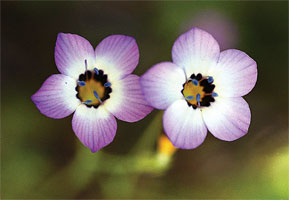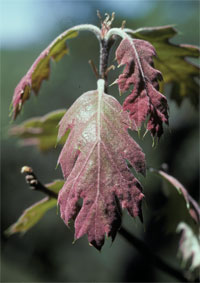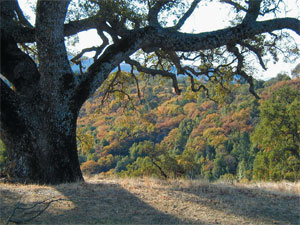Encompassing nearly 90,000 rugged acres of the Diablo Range southeast of San Jose, Henry W. Coe State Park is the largest park in the Bay Area, yet one of our region’s best-kept open-space secrets. With elevations that range from 750 to 3,560 feet above sea level, and areas that vary widely in temperature and rainfall, this hidden but accessible mountain wilderness hosts a great variety of habitats.
The sheer size of the park, along with its range of ecological conditions, allows over 700 species of plants to flourish with extensive populations. Smaller fragments of open space can never support such variety. More than 100 of these plants produce wildflowers, and many of them offer up spectacular displays in the spring, often within easy reach of the park headquarters on Pine Ridge. Though the timing of these displays can vary greatly, depending on conditions such as rainfall and temperature, by a typical April, the park’s meadows are bright green, the deciduous trees have leafed out, and there are wildflowers just about everywhere.
Let’s go back to late October and follow changes in the park’s palette of color through a typical year. The first rains have yet to fall and the golden meadows of the late spring and summer have long since turned silvery gray, the color of a piece of driftwood bleached by the sun. The forest floor is littered with fallen leaves, mostly dusty grayish-brown. With the exception of the leaf bases of the California fescue, a giant native bunchgrass, there is little underfoot that is green.
- Vibrant mosses can green up within a few hours of winter’s first rains. Photo by Barry Breckling.
Come to the park the day after the first rain, head out the Corral Trail, and after crossing the fire road, take the Forest Trail until you come to an inviting sandstone formation to your right. The surfaces of these rocks are almost completely clothed in mosses. Had you been there before the storm, you would have seen an unremarkable dusty-brown and easily fractured mantle on the rock surface. Today, however, there is a beautiful patchwork of textures and different shades of green as the rainfall wets the many different species of mosses that are now harvesting the relatively dim light to perform photosynthesis and grow. The greening process takes little over an hour following initial wetting, and one day is more than sufficient to get these mosses going again.
There is still no other evidence of anything green, though the ground is now damp and the forest litter no longer dusty. However, within two or three weeks following that first rain, a remarkable transformation occurs. Small green shoots emerge from the forest floor, and beneath the remnants of last year’s grasses an unmistakable layer of green is visible. The forest floor and the dormant meadows are coming to life again. It will still be some time before the first wildflowers appear, but there are notable splashes of color courtesy of the bright red berries of the toyon and madrone.
As early as late December, you can often readily identify the leaves of certain wildflower species. The young leaves of the perennial hound’s tongue, found throughout the many wooded regions of the park, are especially prominent. The shape and color of these leaves—several inches long, pointed, and with deep purple veins—are what give this plant its name. Sometimes the entire leaf has a purplish hue to it.
Come back and visit the Forest Trail again around Christmastime. It is still far too early for wildflowers. However, beneath a few of the giant big-berry manzanitas, easily recognizable by their smooth reddish-brown bark, are what appear from afar to be the remnants of a sleet storm. On close inspection the sleet particles resolve into countless little urn-shaped white flowers that have dropped from these strikingly beautiful shrubs. Fresh clusters of white flowers still cling to the tips of the branches of a few manzanitas. These first blooms of the rainy season, although hardly wildflowers in the usual sense of the word, foreshadow the coming of the wildflower season. In a month, there will be what looks like a residual snow patch in the shade of each of the manzanitas.

- March and April bring huge displays of bird’s-eye gilia, which thrives on southwest-facing meadows. Photo by Yoko.
Late January and early February bring into bloom at last the first of the park’s many wildflowers. Among the earliest of these are the milkmaids (sometimes called toothworts), small plants less than a foot high, and bearing several four-petal pure white flowers. By now the forest also harbors spikes of the deep blue flowers of the hound’s tongue and at about the same time the first of the buttercups appear. Lowland shooting stars, resembling a multicolored badminton shuttlecock with pinkish feathers hanging from green stems, can appear en masse in some meadows. The wildflower season has started.
These early wildflowers do particularly well beneath deciduous trees, where they take advantage of the extra light available to them for photosynthesis before the trees leaf out and capture much of it for themselves. Beneath the evergreen manzanitas, by contrast, the dense dark red spikes of Indian warriors appear at about the same time. These plants are semi-parasitic. They invade the root tissues of the manzanitas and steal nutrients from their unwilling host. They can get by with their own photosynthesis, but will take advantage of the manzanitas when given the opportunity.

- New leaves on this black oak show bright red until their photosynthetic machinery is in place. Photo by Don Mason.
Late February and early March present the visitor with another rich tapestry of color, but this time on a grander scale. If you have the energy, climb halfway up the Short Cut section of Hobbs Road as it makes its way steeply to the crest of Blue Ridge from Coyote Creek. Look back across at the face of Middle Ridge. Interrupting the many shades of green are splashes of a subdued reddish color. A number of tree species, especially the deciduous oaks, make reddish pigments in their leaves during early growth. The reddish pigments absorb the sunlight and warm the leaves. This slightly elevated temperature can significantly increase their growth rate. The reddish pigmentation also forms an effective sunscreen, protecting these new leaves as they assemble the components they need for photosynthesis—during which time they are hypersensitive to light. Once the photosynthetic machinery is in place, there is no longer a need for the reddish pigments and they break down and are lost.
As March progresses, the bright yellow pansy-like flowers of the Johnny-jump-ups will dot meadow areas such as Arnold Field, less than a mile from park headquarters. Other areas of Arnold Field will be punctuated with bright orange California poppies, California’s state flower. Neither of these species produces massive colored patches, but they make dramatic contrasting points of color against the bright green of the developing meadows.
Fly into the Bay Area over the Diablo Range sometime in April—occasionally descending airliners pass right over the park—and you are likely to see brilliant yellow patches in the bright green meadows, some as large as several acres. These swathes of color are made up of millions of flowers of a tiny member of the sunflower family, appropriately named goldfields. The mini-sunflowers can compete most successfully where the soil is thin and less than adequate for many other species. There is a meadow along Hobbs Road just before it reaches Coyote Creek on the way to Blue Ridge where you can inspect them close up in a good year. Likewise, the meadows on either side of the Kaiser-Aetna Road into the park from Bell’s Station to the south can host an incredible goldfields display.
Goldfields are not the only flowers to produce masses of color in the meadows. March and April can bring on spectacular displays of bird’s-eye gilias. The five-petal flowers are rimmed with violet and their throat is distinctly yellow. Seeing one of the best displays requires a little bit of energy: Climb partway up the Short Cut section of Hobbs Road, and you’ll find bird’s-eye gilias thriving in huge numbers, especially on open and southwest-facing meadows.
April can also bring large numbers of grand linanthus. Back on the Corral Trail, about a quarter of a mile from the parking area, you come to a steeply sloping meadow extending far above and below the trail. Although the soil here is extremely thin and poor, it is wholly adequate for the grand linanthus; large numbers of these whitish flowers, tinged with violet and perhaps three-quarters of an inch across, flourish there. Chinese houses are another species that can dominate steep meadows. These members of the snapdragon family produce whorls of flowers ranging in color from pale and almost white to lavender with white highlights. If you take the Fish Trail back from Middle Ridge, you’ll cross another steep meadow covered with Chinese houses, to the west of the Little Fork of Coyote Creek.
Offering fair competition to the brilliant displays of linanthus and Chinese houses are some six species of lupine, the earliest and most delicate of which is the miniature lupine. This dwarf species with its blue and white flowers, also growing in whorls around the flowering stalk, flourishes well in open grasslands where the soil is thin. It often grows densely over large areas, making its own special contribution to the color of the landscape.
Both Chinese houses and lupines effectively follow the sun. Lupines keep their leaflets at right angles to the sun to maximize light interception and photosynthesis. The flowers, however, remain arranged symmetrically in whorls around the stalk, oblivious to light direction. Chinese houses have just the opposite response. The leaves remain oblivious to light direction, but the flowers, although in whorls, usually face the light. This is particularly noticeable where they are growing on a steep meadow. All of the flowers face away from the slope, looking for all the world like rows of tiny apartment balconies facing the sun. Johnny-jump-ups are equally talented solar trackers. Walk past a meadow toward the far end of the Corral Trail in the morning and all of the flowers will be facing the rising sun. Walk the same route late in the afternoon and you’ll find them all facing the setting sun. Before dawn, they will switch again using an innate biological rhythm, and will soon be facing the sunrise.
With the cessation of the rains in May (in a typical year), the wildflower season is over—almost. As the grasses turn from green to golden, the pink flowers of a local species of Clarkia begin to appear. These plants may continue to bloom well into the early summer. The flowers, almost an inch across, stand out easily, as so little else is still blooming at this time. Right at the start of the Monument Trail close to park headquarters, there is often a spectacular display of this surprisingly hardy species, pink dots in the meadow below and to the right of the trail.
Two other species produce myriad dots that punctuate the now-golden meadows: the yellow and white mariposa lilies (the latter can either have purple spots or occasionally be entirely purple). Like the Clarkia, they appear on first glance to be extremely delicate. Yet they can endure significant desiccation and high temperature with impunity and may last well into June. Again, they are unmistakable: The flowers, sporting three broad petals, are over an inch in diameter, and there are no brightly colored competitors to catch your eye. Both species are common in the meadows around the junction of the Fish, Flat Frog, and Forest Trails, just over half a mile from headquarters.
Even by the end of June the wildflower season isn’t truly over, since several species can hold out effectively against the scorching summer heat. Summer temperatures often reach the high 90s or above, and coastal fog rarely reaches the park’s high ridges. Among the holdouts are a few California poppies, somehow adapted to cope with the heat and lack of water. Other holdouts are vinegar weed, a blue-to-lavender spike of flowers six or more inches high, and a number of different species of tarweed, both yellow and white. Like many plants from arid regions, they have extremely small leaves with minimal surface area and a mat of hairs that help them to conserve water. Vinegar weed, not surprisingly, has (at least for some people) a strong odor reminiscent of vinegar, while the tarweeds (surprise) smell strongly like tar. In both cases it is likely that these strong odors reflect a defense mechanism against grazing insects and mammals. The smelly compounds may simply make these plants taste awful. It seems a wise strategy for those species that are hanging on alive when almost all of the other wildflower species have long since completed their life cycles and died. Their pungent chemical arsenal provides at least some small protection to ensure the survival of the species. They are not completely immune from serving as food, however, as several insects apparently can tolerate the worst these plants can produce.

- Though no match for a New England autumn, the diversity ofoaks and other trees at Coe Park makes for one of the Bay Area’s bestdisplays of fall color. Photo by Barry Breckling.
By midsummer, most of the tree buds are already dormant. Autumn’s shorter days eventually bring about senescence of the leaves of deciduous trees and shrubs. Their fall colors are somewhat muted in most cases, hardly a match for their New England cousins. However, three species stand out: the big-leaf maple, with bright yellow leaves; the black oak, with leaf color ranging from yellow-orange to red; and, perhaps most spectacular, the scarlet-leaved poison oak. Another beautiful mosaic has appeared. Soon however, the leaves have fallen, the meadows again turn a silvery gray, and the final color tapestry of the year has faded away. The changing of the colors at Henry W. Coe State Park has come full circle and the dormant meadows and forest floor once again await the first rains of winter.
Visit this spacious park many times throughout the year; explore its remote valleys, its airy pine forests, its arid chaparral-covered ridges, its broad flood plains, and its myriad creeks. In this wild place, every corner, and every season, will bring its own new and surprising kaleidoscope of color.
Getting There
Take Highway 101 to Morgan Hill. Take the East Dunne Avenue exit. Turn east on East Dunne and stay on it for 12 winding miles up to park headquarters.

.jpg)




